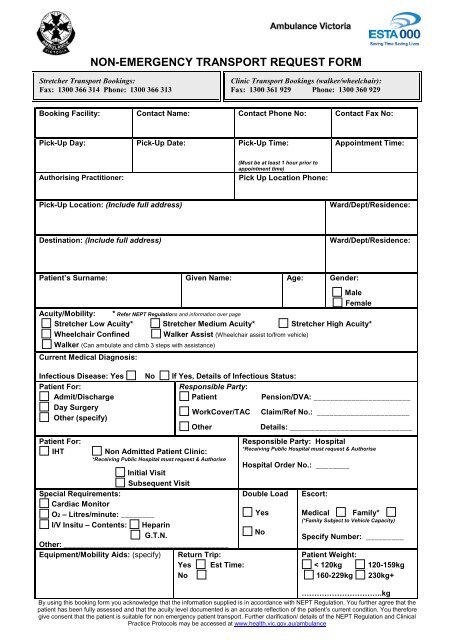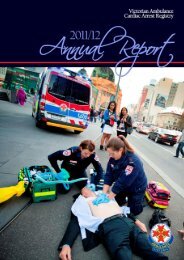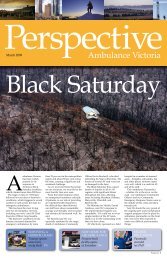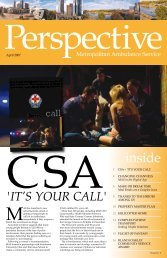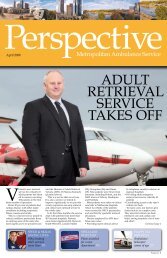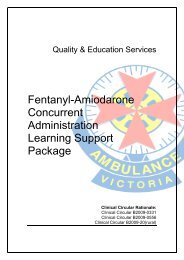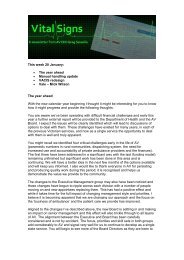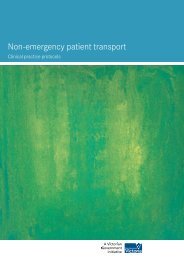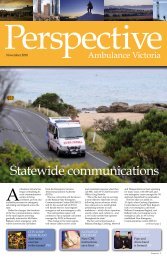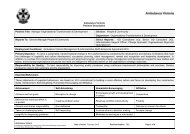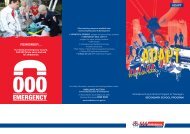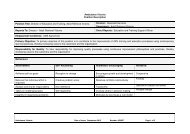NON-EMERGENCY TRANSPORT REQUEST FORM
NON-EMERGENCY TRANSPORT REQUEST FORM
NON-EMERGENCY TRANSPORT REQUEST FORM
You also want an ePaper? Increase the reach of your titles
YUMPU automatically turns print PDFs into web optimized ePapers that Google loves.
<strong>NON</strong>-<strong>EMERGENCY</strong> <strong>TRANSPORT</strong> <strong>REQUEST</strong> <strong>FORM</strong><br />
Stretcher Transport Bookings:<br />
Fax: 1300 366 314 Phone: 1300 366 313<br />
Clinic Transport Bookings (walker/wheelchair):<br />
Fax: 1300 361 929 Phone: 1300 360 929<br />
Booking Facility: Contact Name: Contact Phone No: Contact Fax No:<br />
Pick-Up Day: Pick-Up Date: Pick-Up Time:<br />
Appointment Time:<br />
Authorising Practitioner:<br />
(Must be at least 1 hour prior to<br />
appointment time)<br />
Pick Up Location Phone:<br />
Pick-Up Location: (Include full address)<br />
Ward/Dept/Residence:<br />
Destination: (Include full address)<br />
Ward/Dept/Residence:<br />
Patient’s Surname: Given Name: Age: Gender:<br />
Male<br />
Female<br />
Acuity/Mobility: * Refer NEPT Regulations and information over page<br />
Stretcher Low Acuity* Stretcher Medium Acuity* Stretcher High Acuity*<br />
Wheelchair Confined Walker Assist (Wheelchair assist to/from vehicle)<br />
Walker (Can ambulate and climb 3 steps with assistance)<br />
Current Medical Diagnosis:<br />
Infectious Disease: Yes No If Yes, Details of Infectious Status:<br />
Patient For:<br />
Responsible Party:<br />
Admit/Discharge<br />
Patient<br />
Pension/DVA: _______________________<br />
Day Surgery<br />
Other (specify)<br />
WorkCover/TAC Claim/Ref No.: ______________________<br />
Other<br />
Details: _____________________________<br />
Patient For:<br />
IHT<br />
Special Requirements:<br />
Cardiac Monitor<br />
Non Admitted Patient Clinic:<br />
*Receiving Public Hospital must request & Authorise<br />
Initial Visit<br />
Subsequent Visit<br />
O2 – Litres/minute: ________<br />
I/V Insitu – Contents: Heparin<br />
G.T.N.<br />
Other: _______________________________________<br />
Equipment/Mobility Aids: (specify) Return Trip:<br />
Yes Est Time:<br />
No<br />
Responsible Party: Hospital<br />
*Receiving Public Hospital must request & Authorise<br />
Hospital Order No.: ________<br />
Double Load<br />
…………………………..kg<br />
By using this booking form you acknowledge that the information supplied is in accordance with NEPT Regulation. You further agree that the<br />
patient has been fully assessed and that the acuity level documented is an accurate reflection of the patient’s current condition. You therefore<br />
give consent that the patient is suitable for non emergency patient transport. Further clarification/ details of the NEPT Regulation and Clinical<br />
Practice Protocols may be accessed at www.health.vic.gov.au/ambulance<br />
Yes<br />
No<br />
Escort:<br />
Medical<br />
Family*<br />
(*Family Subject to Vehicle Capacity)<br />
Specify Number: _________<br />
Patient Weight:<br />
< 120kg 120-159kg<br />
160-229kg 230kg+
DO NOT FAX THIS SHEET<br />
Low-Acuity Patients<br />
DEFINITIONS OF PATIENT ACUITY<br />
A low-acuity patient is defined as a patient in whom all the following apply:<br />
1. An assessment has been made by an appropriate health professional that the patient is stable<br />
for the duration of the transport<br />
2. The patient has no emergency clinical symptoms or signs of recent onset (as outlined in NEPT<br />
Clinical Practice Protocols “Definitions of Adult Emergency Patient’)<br />
3. The patient has an illness or injury that does not require active treatment but which does require<br />
supervised patient transport. Examples include;<br />
• Inability to travel in a normal seated position<br />
• Requirement for oxygen during transport<br />
• Impaired cognitive function<br />
• Inability to travel more than a few steps unaided<br />
It is also acceptable for NEPT to transport a patient who is not acutely ill, but who requires stretcher<br />
transport because of a chronic medical condition (such as quadriplegia) and who is unable to access a<br />
suitable alternative form of transport.<br />
Medium-Acuity Patients<br />
A medium-acuity patient is defined as a patient who requires active monitoring or management and in<br />
whom all the following apply:<br />
1. An assessment has been made by a medical practitioner that the patient is<br />
haemodynamically stable for the duration of the transport<br />
2. There is no likelihood that the patient will require transport under emergency conditions<br />
3. The patient does not meet the criteria of an emergency patient (as outlined in NEPT Clinical<br />
Practice Protocols “Definitions of Adult Emergency Patient’)<br />
4. There is an illness or injury which requires one of more of the following:<br />
(a) cardiac monitoring<br />
(b) observation and monitoring of an intravenous infusion of a crystalloid fluid, with or<br />
without an infusion pump<br />
(c) observation and monitoring of an intravenous infusion of crystalloid fluid containing<br />
glyceryl trinitrate or heparin using (an) infusion pump(s)<br />
(d) care of an intercostal catheter or central venous catheter<br />
(e) care of the patient who has a recent fracture of the spinal column (without spinal cord<br />
injury)<br />
(f) care of the patient on home ventilation<br />
Medium acuity status also applies if the patient has a mental illness and is assessed as behaviourally<br />
stable by the sending practitioner, and meets the criteria described under ‘patients with a mental illness’.<br />
High-Acuity Patients<br />
A high-acuity patient is defined as a patient in whom:<br />
1. An assessment has been made by a referring medical practitioner that the patient is stable for<br />
the duration of the transport<br />
2. There is no likelihood that the patient will require transport under emergency conditions<br />
3. The patient does not meet the criteria of an emergency patient (as outlined in NEPT Clinical<br />
Practice Protocols “Definitions of Adult Emergency Patient’)<br />
4. There is an illness or injury, which requires active monitoring or treatment by a nurse or medical<br />
practitioner, including:<br />
• Mechanical ventilation<br />
• An intravenous infusion of a vasoactive drug<br />
• A patient with tracheostomy<br />
• A patient with a central or arterial line<br />
• A device which supports the circulation (intra-aortic balloon pump or extra-corporeal<br />
membrane oxygenation)


